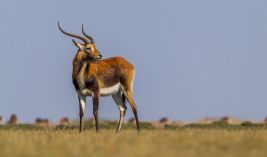South Africa
South Africa: Countless hunting possibilities - and a great place to bring your family along

Highlights
- Good Game Population and Trophy Quality
- Many different species
- Huge Hunting Areas
- Perfect, when you want to combine hunting and tourism
- Perfect, when you want to bring along your family
Hunting in South Africa
In the northern part of South Africa - in Limpopo Province - we work with GS Safaris, which is a fantastic place ! - not only for the hunter, but also for his family. .
In the Eastern Cape province we work with four different safari companies - Frontier Safaris, Loock Safaris, E-Zulu Safaris and African Echo Safaris. The last-mentioned has two different hunting areas in Eastern Cape, as well as a hunting area in the Kalahari.
With Frontier Safaris you can get the cheapest hunting trip in the market. And even though the price is discount (0 Euro for 6 days stay and 5 hunting days 2:1), we do not compromise either with the size of the hunting area (27.000 hectares), nor the population of game or the accommodation.
Loock Safaris is situated close to the town of Graaff-Reinet, and here we can offer trophy hunting and cull hunting. On a lot of interesting species.
African Echo Safaris is our latest addition to partners in South Africa - here you get good hunting at very reasonable prices.
E-Zulu Safaris ist the place to choose, if you want luxury in all aspects.
So, as you see, we have lots of things to offer in South Africa - please see more about the different hunting trips under Tours.
Video Gallery

-
 RH Safaris - Duck shooting
RH Safaris - Duck shooting -
 African Echo Safaris - Burkina Faso
African Echo Safaris - Burkina Faso -
 RH Safaris doves & pigeons
RH Safaris doves & pigeons -
 Duck shooting - RH Safaris
Duck shooting - RH Safaris -
 Hunting in Africa
Hunting in Africa
Hunting stories
Pigeon hunting in South Africa
Great bird hunting, good challenge, for even the experienced shotgun.
Ca. 2 to 2 1/2 hours drive from Johannesburg International Airport.
We chase the pigeons on their migratory routes, between the many living fences, and the pigeon foraging sites.
From the smaller pigeons that fly at eye level, and to the slightly larger "Rock pigeons" that pull up to 45 meters in height.
Our hunts are arranged so that we have our helper, to pick up pigeons, bring cartridges, drinks, move our brought chairs in case the tow route changes, make parade, etc.
Depending on the hunter's wishes, we typically shoot 400 - 1000 shots per day. Per hunter.
We stay in a lovely guesthouse or lodge, depending on where the pigeons draw best.
Accommodation, food, moderate-size beverages, and transportation during the hunt are included.
Our partner has 6 semi-automatic shotguns that we can rent if you do not want to bring your own shotgun.
The pigeon hunts can be combined with other bird hunts, as well as hunting for trophy-bearing antelopes.
Jens Ulrik hunts for Kudu
Come with Jens on a kudu hunt to a wild corner of Africa where black rhinos roam among incredible kudus, bushbucks and waterbucks...
Land of giants
I always go hunting with great expectations. To travel without the slightest idea of what adventures are lying ahead is a thrill very similar to the bubbling sensation I used to feel in my stomach the night before my first dozen of birthdays. The certainty that the next day would be great combined with the uncertainty of what would actually happen was excitement in its purest form. The birthdays became predictable and the tickling butterflies on the inside left for good but the childish magic in the joy of expectation remained when it comes to hunting adventures.
In this case, I truly had something to look forward to. The hunting area used by Limpopo Safaris is a huge privately owned nature reserve covering an area of 65,000 hectares. I have been there before. Twice actually and I have come to regard the outfitter Mias Cronje and his lovely wife Bella as good personal friends.
Upon my arrival we test fired the rifle late in the evening in the lights from the car. It was dead on as always. Mias wanted to go kudu hunting early next morning!
Nature paradise
We started our first hunting day with a long walk along the Nzehelele River a tributary to the mighty Limpopo River that forms the areas boundary to Zimbabwe. The landscape was wild and impressive. So was the game populations. Along the deep and rocky riverbed, we saw plenty of waterbuck, bushbuck, kudu, nyala and bush pig. Big crocodiles patrolled the shallow water and a grumpy old black rhino bull demanded our constant attention.
The trophy quality in the area is the result of efficient management. Just 15 years ago this enormous hunting area was a number of worn down cattle farms with very little wild life living in the bush. An investor with a keen interest in nature conservation bought the farms and cleaned up the bush. The area was game fenced and one by one all the indigenous species were acquired and reintroduced into areas where they had been absent for more than a century. Today wild bush has reclaimed the cattle pastures and the area is home to more than 30 huntable species of big game.
All the game populations sustains themselves and there is more than enough room for “difficult” species. Thus the area have strong and growing populations of leopard, spotted and brown hyena, African wild dog, crocodile and all the small wild felines that belong in this part of the world. Only the lion is still missing – due to legislative issues – but it is on its way. To the owners it is all about creating a closed African eco-system – a sanctuary for the wild Africa. Hunting is simply a management tool and a way to finance the whole thing. Quotas are very strict.
Jens the squirrel
On our way back from the morning stalk Mias and Hassan were very cautious. They had no idea of the exact whereabouts of our friend Mr. Rhino and they paused often to spot him before he spotted us. This part of the area is not usually used for hunting guests. I only managed to convince Mias to take me there because I insisted that I was an excellent tree climber and because he did not realize that I am a very poor judge of my own abilities (or lack of same)…
They spotted our heavy buddy on the opposite bank. He was browsing peacefully on dry bushes. We stopped to take photos of the big fellow. He was slowly moving towards us and soon he was within 50 meters. We quietly observed and had already chosen our personal trees should the situation suddenly escalate.
When we felt the breeze against the back of our heads, it was already too late. The hardly noticeable wind had turned to carry our scent directly to the black rhino bull at the bottom of the river. He blinked his beady little eyes raised his head and sniffed the wind. In the next second he exploded in furious rage.
The angry bull snorted as he accelerated from zero to top speed in a couple of leaps. He was headed straight for us. I jumped up and ran the few meters to my tree while Mias calmly distracted the mastodon. I got far in to the tree in no time flat. Actually, I am convinced that I would have been able to climb to the top of a polished flag pole covered in green soap! After a few minutes display of brutal force the bull went back to his own side of the river and we sneaked off to the car.
They say that fear is not real. That is a feeling we choose. I do not know if that is true. I do know that I chose to throw out my underpants when we got back that evening and I did not forget to kiss my Härkila Rhino boots goodnight in appreciation of their tree climbing qualities…
Kudu in sight
We were out early the next morning searching for the strong kudu bulls that are so typical for this area. We had been driving for less than an hour when Hassan spotted two kudu bulls through thick Mopani bush. He could not however get a clear view of their horns. Never the less he had a hunch that they were strong bulls and he convinced Mias to take a closer look.
The bulls were several hundred meters from the car headed towards a steep formation of rocks far from the dirt track we were driving on. 500 meters further ahead Mias turned the Land Cruiser toward the ridge hoping that we would get a chance to see these bulls from the top of the red rocks.
The track went all the way to the top. Mias stopped the diesel engine long before we reached the edge and we silently left the car. We were on a flat plateau high above the plain that stretched from the foot of the cliffs towards the river and its dense green vegetation that made it look like a gigantic green snake moving through the landscape.
Directly below us a pair of young waterbuck bulls got on their feet. They clearly sensed our presence without really realizing the nature of the threat. I took a good look at these magnificent animals through my binoculars as they slowly descended down the side of the cliff sending loose rocks rolling with every step they took.
From the corner of my eye I saw Mias drop to his knees. Instinctively I followed him without knowing why he did it. Mias threw his binoculars before his eyes and starred intensely downhill in a completely different direction than the vanishing waterbucks.
His whispered exited. “Do you see that kudu bull?”
I followed the direction he was looking and there – only about 100 meters down – a giant kudu bull grew out of the shadows beneath a tree that it was feeding on. I quickly got my own set of binoculars in action and a crystal clear image of the magnificent animal appeared before my eyes. My heart skipped a beat or two. This was indeed a sight for sore eyes! The long horns of this bull was curling in deep black turns towards the sky in perfect V-formation. The amber colored tips seemed to be extremely far away from the bases of the horns that were as thick as a grown man’s arms.
“I want you to shoot that bull.... NOW!” Mias was very insisting – and I was not hard to persuade…
You never know!
I crawled back to the car to get the Mauser. As silent as I could I sneaked a round into the chamber and made sure the rifle was not cocked. As fast as I could I crept back to Mias and Hassan who was still starring at the kudu bull below. I moved the last bit like a snake on the rocks and got in position between the others. I was lined up for a pretty easy shot from prone position with – literally – rock steady support.
I turned the Zeiss scope to 10X magnification and lit the fine red center dot for better contrast against the dark silhouette of the bull. My thumb worked the cocking lever without effort and my finger softly found the trigger as I oozed down behind the scope.
He was right at the edge of my sight picture facing us at an angle. I let the glowing red point slide to the center of his chest and let the shot off.
The bull jumped and kicked violently with his hind legs. His left front leg dangled from his body and dark red blood was pumping from the exit wound behind his shoulder. He turned on three legs and ran downhill headed for the thick bush below. The signs were clear – everything looked just fine. But the bull did not stop and drop as soon as we expected him to do so.
He just carried on and was soon at 200 meters distance. I fired a shot through the top of the trees against the dark silhouette. The bullet deflected and went high over the back of the animal. He was now trotting. Another shot – this time at well over 250 meters – failed to penetrate the Mopani bush. But the kudu was slowing down clearly affected by the first shot.
In front of the animal, I saw an opening between two trees. With a single push on the button on my rangefinder Mias measured the distance to 312 meters. I set the ASV+ turret on the scope at 310 meters and could easily send the last bullet in the magazine into the spine of the bull stopping him on the spot.
Strange! Both Mias and I felt sure that the first bullet was perfect and even though the bull was clearly dying it should not have been able to run that far.
Fantastic trophy
Ten minutes later we caught up with the dead bull between the Mopani trees. The huge trophy was by no means less impressive at short distance. This strong old gentleman had seen his share of fighting and he had probably won most of those battles to claim his place in the gene pool
At closer inspection the reason for the longevity of the wounded bull became clear. My first shot had only destroyed one of the bull’s lungs. It was dying when my last bullet struck it to the ground but it would have died within a few meters had I placed my first bullet through the top of the heart.
With a valuable lesson learned and an incredibly beautiful trophy in the salt, we spent the rest of my visit to this spectacular area taking pictures of the abundant wildlife, fishing brim among the crocodiles and – with big grins on our faces – reassuring each other that we tend to give ourselves waaay to little credit…
I saw lots of kudu, bushbuck and nyala with unbelievable trophies and I’ll be very surprised if this area will not dominate the top of the trophy lists for waterbuck within the next decade. I’ve seen several candidates for the top ten with my own eyes. I’ll be back!
MY GEAR
ZEISS: On this trip I am bringing a set of Zeiss Victory HT 8X42 binoculars and a Victory 8X26 PRF rangefinder to complement the rifle scope - a Zeiss Victory HT 2.5-10X50 equipped with the ASV+ ballistic turret. Nothing but the best!
MAUSER: The rifle is a Mauser M03 African PH in .300 Winchester magnum caliber. It turned out to shoot extraordinarily accurate with Norma Oryx 180 gr. ammo. I feel very safe using this particular model as it incorporates a very user friendly hand-cocking devise instead of a conventional safety.
HÄRKILA: I use the strong Oryx pants that fits like a good pair of jeans. A classig safari shirt keeps my skin cool and out of the sun. Both pants and shirt are made from cotton. My feet are comfortably protected by a pair of light Rhino leather boots. A very good choice for hunting in hot weather.
Jens Ulrik i Zulu-land
Black prince of Zululand
Mark Dedekind Safaris south of Pongola in Kwazulu Natal had kindly invited us to hunt red duiker and nyala
– two very typical species for this part of South Africa.
The red duiker was usually the more difficult of the two species to get with only five animals on the yearly quota in the privately owned Mahlalela nature reserve spanning almost 11,000 hectares. We would therefore start our hunt looking after one of these small animals.
Once again I was hunting with my Mauser M03 African PH in .300 Winchester Magnum with a Zeiss Victory HT 2.5-10X on top. Certainly too much gun for an animal weighing only about 12 kg but for the nyala the caliber was suitable and therefore I felt it was a very good all-round rig for this hunt. I simply had to be careful to place the bullet behind the shoulder on the red duiker to give the taxidermist a fair chance.
It took us more than an hour to drive the long way from the lodge over the mountain and down to the bottom of the next valley. On the way we passed an impressive diversity of typical Zululand habitat ranging from dense camel thorn bush over enormous open grass plains at high altitudes to thick jungles filled with red duikers along the rivers at the bottom of the valleys. Freddy Robertson – my experienced PH – knew this enormous area like the back of his hand. On our way to the riverine forests he had explained exactly what the plan was. We would find a nice starting point on the river. From there we would slowly stalk as quietly as possible against the wing pausing frequently to observe. The little red duikers are extremely shy and very alert. If they see the hunters they immediately disappear in the undergrowth.
We moved slowly forward under the canopy. The forest floor was covered in dead branches at crackling dry leaves. I stayed right behind my PH and tried to walk in his pace to make as little noise as possible. The forest was silent as the grave and every little twig that snapped under our foot soles sounded as painfully noisy as a chainsaw in a library. We crossed back and forth over the dried out river bed and stopped at the smallest sound or movement. After less than twenty minutes we spooked the first duiker of the day without any chance of seeing whether it was male or female. Ten minutes later we did it again. Duikers vs. Jens 2-0
Crested guineafowl
Freddy was clearly enjoying this quiet stalk. His smiling enthusiasm was contagious and I was taken by the challenge. Suddenly Freddy froze. A few meters in front of us a small flock of crested guinea fowl was mowing between the bushes. Red duikers are often following these birds as all their scraping reveals lots of delicious food for the duikers. Without a movement he studied the area surrounding the birds resting his binoculars on the shooting sticks. Several long minutes passed before we saw some red movement in the bushes. A red duiker appeared less than 20 meters in front of us. It was constantly moving and energetically wagging its relatively large tail like a happy little dog.
Both male and female red duikers have horns. It is therefore difficult to judge the sex by the look of the head. So Freddy was looking for testicles. Actually for the set of large – or rather huge – testicles that all male duikers carry around considering the relatively small size of these animals. The red duiker in front of us had none. In other words she was a little lady.
The Husband arrives
We both saw the movement in the bush behind the princess. Another duiker had entered the scene. Freddy did not need to look at his private parts to conclude that it was an old male. The thick horns beyond the long hair on his head gave him away. And so did his shameless pursuit of the young female. Freddy carefully put up the shooting sticks and I tried to get in position but the duikers had other plans and moved their activities to another bush during the couple of seconds it took me to get ready. Freddy took a chance and asked me to aim for an opening between the bushes. With a little luck the duikers would appear there. The distance was less than 20 meters. I quietly got in position and waited. I saw a tiny shadow getting closer to the opening. I cocked the action and moved my finger to the trigger. The fine dot of red light in the center of the cross hairs was already lit. Freddy studied the animal intensely through his binoculars. ”Not that one – it’s the female”, he whispered.
I moved my index finger outside the trigger guard. The female stopped in the middle of the opening starring right at us. It was the only time I saw a duiker stand still and the moment didn’t last for more than a second or two. She quickly moved on warning the male who appeared in the same opening just seconds later. ”Shoot!” Freddy said and a shot aimed at the middle of the small silhouette rang out in the forest. The duiker fell down but he immediately got back on his feet and began spinning around for a few seconds before everything was quiet.
”Did you see the tree you clipped?” Freddy asked. I did not. Approximately half way between the muzzle and the duiker the bullet had tarred a small tree apart. Luckily this did not change the course of the bullet substantially. Luck is allowed! The little red duiker was out of it…
What a start, what a hunt! An ancient male with thick horns lay dead on the ground. A beautiful and peculiar animal and a very challenging hunt.
In the afternoon Freddy showed me around in the incredibly beautiful reserve. Zululand’s carrying capacity is among the best in Africa. In this area game is abundant and in very good condition.
Stalking the nyala
We could feel it as we got up early the next morning. The temperature and humidity was rising. We expected a hot day – and we had one! The more than 1,500 nyala in the areas was playing hide and seek in the heat. During a long and sweaty morning stalk we only saw a single female in an area that is usually crawling with nyala. Going back for lunch we had the good fortune to be able to cull an old wildebeest bull in the open grasslands so the mornings hunt was far from fruitless.
In the afternoon we spotted lots of nyala and we stalked a few up and down steep and rocky hill sides. But none of them turned out to be the kind of bulls Freddy was looking for. The late afternoon was sizzling hot with 38 degrees Celsius in the shadow. We drank liters of water.
Our third and last hunting day started out even hotter than the day before. Not a good thing for our nyala hunt. They simply moved to little around to be spotted in the dense areas of bush. Despite some very serious efforts we didn’t manage to get an opportunity to bag a large bull that morning.
We started hunting again early in the afternoon. This was our last chance! Maybe I was not meant to bag a nyala this time around? It was nothing to complain about really. I already had a fantastic hunt, and it wouldn’t be hunting if the outcome was given.
Now or never!
The nyalas was more on the move in the afternoon but still not as much as Freddy would like them to move. We stalked a couple of promising bulls but we were out of luck. The sun was setting behind the mountain as we slowly headed towards the lodge.
Nothing is over before the fat lady sings! Freddy saw two bulls in open bush close to the track. A very young and a very old bull was grazing side by side. We drove a few hundred meters and turned right on another road. A little further ahead Freddy stopped the engine and we quietly left the vehicle. I chambered a round and checked that the action was uncocked and safe. I lit the illuminated center dot in the scope and turned the magnification all the way down to 2.5X.
Our plan was to sneak quietly through the few hundred meters of bush and hopefully find the old bull on the other side. If we bumped into the animals on the way our only option would be a shot at very close range in the thick stuff in front of us.
A light breeze was blowing in our faces. The wind was perfect. We tried to be as silent as possible and moved forward very slowly. A carpet of dry leaves on a bottom of dead branches and twigs bedded in crisp red gravel and loose rocks proved to be quite a challenge to our ambitions of stealth. We looked like Indians in artistic slow motion as we slowly oozed our way through this jungle…
Obstacles
After a little more than a hundred meters ultra-slow advance we reached a dry river bed. A vertical brink of loose dirt with roots sticking out led to a stony bottom four meters below. The opposite brink was equally steep. There was no hope of getting across here!
Freddy starred a little disappointed at the gorge in front of us, but he immediately stalked along the river to try and find a place to cross. Only a few meters further ahead an opportunity presented itself in the shape of a narrow path opened by the nyalas themselves. We crawled under a dead tree and carefully slid down the brink holding on to one of the thick roots on the way. On the other side we repeated the exercise in reverse order.
Freddy carefully raised his head over the edge. Less the 70 meters in front of him the young bull was still grazing peacefully. Freddy slowly looked to the right and there – only 15 meters in front of him – the old bull was feeding towards us! Freddy ducked in slow motion and whispered as silent as he could that I should move around him and kill the bull in front of us. I managed to get around him in slow motion and I raised the rifle as I looked over the top. But we were busted - A nyala does not grow ears the size of a saucer for the fun of it!
Action!
When I cleared the edge I stood face to face with a very alert nyala bull at a distance of 10 meters. We were starring each other directly in the eyes. The moment hardly lasted half a second. The bull threw himself around and ran off at full speed.
”Jump up and see if he stops” Freddy hissed. I was already over the edge!
A second later I saw the fleeing nyala through thick bush at 30 meters – and he saw me! With a powerful jump he turned 90 degrees and started running away from the river at full speed displaying his entire broadside. Instinctively I had thrown the rifle to the shoulder, cocked it and was now following the running bull through the scope. I was on auto-pilot in driven hunt mode! A little further ahead of him I saw an opening in the bush. When the bull passed it my index finger was happy with the sight picture and pulled the trigger. The shot went off and hit the nyala in midair exactly where the neck is attached to the spine.
His lights went out in as the bullet struck him and he collapsed and fell like a sack of potatoes. He was dead before he hit the ground and he raised a big cloud of red dust as he rolled lifeless on the ground. “...or you can do it like that” Freddy cheered loudly behind me. I chambered another round and focused on the bull approximately 60 meters away. His violent kicking left no doubt. The black prince had passed on to the eternal version of Zululand’s lush bush land. I could hear my own pulse and I could feel the sweat running down my body staining my khaki cotton shirt. But I also felt the corners of my mouth getting closer to my ears…
MY GEAR
ZEISS: Victory HT 2.5-10X50 scope.
A very good all-round scope with a versatile zoom range, good light transmission in dark environments and a very fine red center dot in the middle of the reticle. Conquest HD 8X42 binoculars. Mauser: M03 African PH in .300 Win. Mag. A safe, well balanced and very accurate rifle. A good all-round weapon for African plains game. Härkila: Khaki safari shirt and long oryx pants. Both in 100% cotton for maximum coolness. I wear long sleeves and legs because of the sun and the snakes. My feet are very happy with the Rhino leather boots - the perfect safari boot. It’s light, has a good grip and it is very strong!
Game

African Black duck*
Scientific name: Anas sparsa Distribution: This species is widespread over central and southern Africa Habitat: The African Black duck mainly lives in freshwater districts with plenty of aquatic vegetation and areas of grassland. It feeds off aquatic plants, insects and other small animals found in the water. It is mainly found on water with a depth of less than 1.5 meters. Description: It has...
Read more
African Civet
Scientific Name: Virerra civetta Subspecies: There exist several subspecies of Viverra civetta, but they are not described here as they have little or no significance as hunting trophies. Distribution: Most African countries south of the Sahara Desert. Habitat: All types of savanna, sometimes dense forest. Description: Dog size animal, looking like a mixture between a stoat and a badger....
Read more
Baboon
Scientific Name: Papio sp. Sub-species: Five species are currently recognised (this is some disagreement on whether they are true separate species or sub-species. The true number of sub-species is also currently unknown) Hamadryas baboon (P. hamadryas) - Horn of AfricaGuinea baboon (P. papio) - Far western AfricaOlive baboon (P. anubis)- north central african savannahYellow baboon (P....
Read more
Barbary Sheep
Scientific Name: Ammotragus lervia Subspecies: A number of geographic subspecies are recognised, but we mention only the two that are huntable at present: Kordofan Barbary Sheep (Ammotragus l. blainei) Sahara Barbary Sheep (Ammotragus l. sahariensis) Distribution: Kordofan Barbary Sheep: Sudan Sahara Barbary Sheep: Chad. Habitat: Rocky dry mountains and broken country of the Saharan...
Read more
Black Wildebeest
Scientific Name: Connochaetes gnou Subspecies: none Distribution: South Africa ( lives on game farms in Namibia) Habitat: Open grass veld and subdesert steppes. Description: Middle-sized animal of the Gnu-family with a weight of 150 - 170 kg and a shoulder-height of 120 cm. General colour dark brown to jet black and its tail is pure white. A characteristic feature of the White-tailed Gnu is...
Read more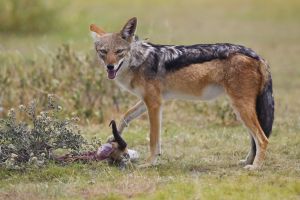
Black-backed Jackal
Scientific Name: Canis mesomelas Subspecies: None. Distribution: South Africa, Namibia, Botswana, Zimbabwe, Mozambique, Tanzania, Kenya, Uganda, Somalia and Ethiopia. Habitat: Open savanna and light woodland. Description: A brightly coloured jackal, with a rather fox-like head, and long ears, broad at their bases and pointed. It weighs around 10 kg and measures 45 cm over the shoulder. Head...
Read more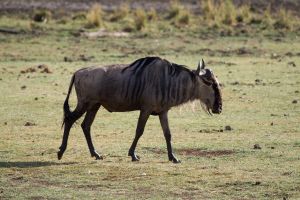
Blue Wildebeest
Videnskabeligt navn: Connochaetes Taurinus Underarter: White-bearded Wildebeest (C.t.mearnsi), Cookson's Wildebeest (C.t.Cooksoni) Udbredelse: Blue Wildebeest: Zimbabwe, Zambia, Mozambique, Sydafrika, Namibia. White-bearded Wildebeest: Tanzania, Kenya. Cookson's Wildebeest: Luangwa Valley i Zambia Levested: Findes i alle former for bushlandskab, men foretrækker åben bush og...
Read more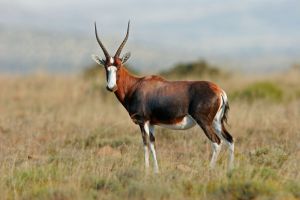
Bontebok/Blesbok
Scientific Name: Damaliscus dorcas Subspecies: Blesbok (Damaliscus d. phillipsi) Distribution: South Africa and Namibia (in game farms) Habitat: Open bush and grassland Description: The two species are here described as one as the difference between them is negligent. (Bontebok is darker in colour, has deeper grooves in its horns, has all white legs and the facial white band is usually...
Read more
Buffalo, Cape
Videnskabeligt navn: Syncerus caffer Underarter: Dværgbøffel (Cyncerus c. nanus), Savannebøffel (Cyncerus c. S. c. brachyceros ), Nilbøffel (Syncerus caffer aequinoctialis). Cafferbøffel (Cyncerus caffer caffer Udbredelse: Nilbøflen er den af de fire arter der har det nordligste udbredelsesområde: Fra Senegal i vest i et bredt...
Read more
Burchell's Zebra
Videnskabeligt navn: Equus burchelli Underarter: Grant's Zebra (E.b. böhmi) Chapman's Zebra (E.b.antiquorum) Udbredelse: Burchell's Zebra: Botswana og Sydafrika. (den ægte burchell's zebra er uddød). Grant's Zebra: Mozambique, Tanzania, Kenya, Uganda og Ethiopien. Chapman's Zebra: Sydafrika, Mozambique, Zimbabwe, Botswana, Namibia, Angola, Zambia. Levested: Åben bush og...
Read more
Bush Pig
Scientific Name: Potamochoerus porcus Subspecies: Up to 18 recognised species, here described as one. Distribution: All of Africa south of the Sahara Desert, excepting the desert of Namibia. Habitat: High forest, their fringes and thick bush country, often near rivers. Frequents fields where they cause much damage. Description: A domestic pig-like animal, weighing around 100 kg and measuring...
Read more
Bushbuck, Cape
Scientific Name: Tragelaphus Scriptus Subspecies: Science dissagree as to how many species there are. We have chosen to include those most relevant to trophy hunters: Tragelaphus s. ornatus, Tragelaphus s. massaicus, Tragelaphus s. sylvaticus. Distribution: Tragelaphus s. scriptus: The West African States Tragelaphus s. ornatus: Zimbabwe, Zambia, Zaire and East Angola Tragelaphus s. massaicus:...
Read more
Cape Grysbuck
Videnskabeligt navn: Raphicerus melanotis Underarter: Ingen. Udbredelse: Sydafrika. Levested: Tæt bush og høje græsbevoksninger. Beskrivelse: Lille antilope med en vægt på 8 - 12 kg og en skulderhøjde, der normalt ikke overstiger 50 cm. Grysbucken er gråbrun med hvide aftegninger over øjnene og under halsen. Hornene, der er meget små,...
Read more
Cape shoveler*
Scientific name: Spatula smithii Distribution: Widespread in southern and central Africa. Habitat: The Cape Shoveler mainly lives in large open areas of freshwater and wet grasslands with emergent vegetation. It largely lives off aquatic plants, and is normally found in water that is less than 1.5m in depth. Description: It can be identified by its longe, large bill, and its brown plumage with...
Read more
Cape teal*
Scientific name: Anas capensis Distribution: The Cape Teal is widespread in South Africa, being most numerous in the drier regions of South Africa such as the Western Cape, North-West and Free State Provinces. Habitat: It mainly lives in large open areas of freshwater and wet grasslands with emergent vegetation. It largely lives off aquatic plants, and is normally found in water that is less...
Read more
Cape turtledove
Scientific name: Streptopelia capicola Distribution: It is a widespread and often very common species in southern and east Africa. Habitat: It is common in most urban areas, where it favours both large and small trees in parks and gardens. In sunflower and corn fields close to towns it offers excellent sport for wing shooters as it is very fast flying. Description: The Cape turtle...
Read more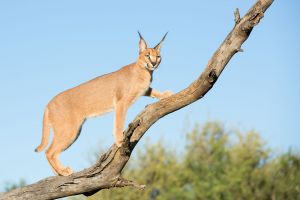
Caracal (Afrika)
Scientific Name: Profelis caracal Subspecies: Geographic subspecies, but all are here descriped as one. Distribution: Are found in most of Africa, apart from the Central- and West African States. Habitat: All types of savanna, often in the vicinity of rocks. Description: A fairly big and robustly built cat, with the proportions of a lynx. It weighs around 25 kg and has a shoulder height of 50...
Read more
Common quail
Scientific name: Coturnix coturnix Distribution: It is widespread in Europe and in northern and southern Africa. It is a member of the pheasant family. Habitat: It is a ground living bird found in large open areas, grasslands and farmland. It mainly lives off seeds and insects and can wander over large distances. Description: This is the smallest bird it is legal to hunt in South Africa. It is...
Read more
Crocodile, Nile
Scientific Name: Crocodylus niloticus Subspecies: No subspecies are currently formally recognised, however up to seven have been proposed. Distribution: The most common African crocodile, present over much of the sub-Saharan Africa from Lake Nasser in Egypt and the River Nile Sudan to the north to the Okavango Delta of Botswana and the Olifants River of South Africa in the...
Read more
Double-banded sandgrouse
Scientific name: Pterocles bicinctus Distribution: It is widespread in South Africa and can also be found in a number of other African countries. Habitat: It lives in dry grass areas often beside roads and tracks, gravel patches recently burned areas with developing grass shoots. It mainly feeds on grass seeds. Description: The double banded sandgrouse is a pigeon sized bird, with light brown...
Read more
Dove, Rock-/Pigeon, Blue Rock-
Scientific Name: Columbia livia Subspecies: 12 different subspecies have been recognised, some possibly derived from feral populations. Feral pigeons are actually derived from domesticated rock doves, and wild and feral birds often interbreed, Distribution: Originally the rock dove was a native of western and southern Europe, North Africa and South Asia. It was now been introduced to many...
Read more
Duiker, Blue
Scientific Name: Cephalophus monticola Subspecies: Up to 18 subspecies of the Blue Duiker are recognised. Distribution: Cameroun, Gabon, Congo (Brazz.), Congo (Zaire), Uganda, Tanzania, Kenya, Zambia, Mozambique, Zimbabwe and South Africa. Habitat: Densely wooded country. Often along rivers. Description: Small antelope weighing 8 - 10 kg with a shoulder height of 30 - 40 cm. General colour...
Read more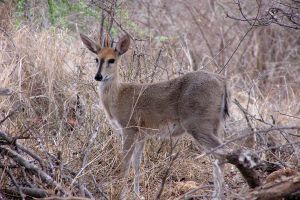
Duiker, Grey/Duiker, Grimm's (Common)
Scientific Name: Sylvicapra Grimmia Subspecies: Classification of subspecies is very variable, we have chosen only to count two: Western Bush Duiker and East African Bush Duiker. Distribution: From the desert rim in Northern Africa to the Southern tip of the Continent, the West African rainforest excepted. Habitat: As the species is a typical bush duiker it lives, as the name suggests in...
Read more
Egyptian goose
Scientific name: Alopochen aegyptiaca Distribution: The Egyptian goose is originally from sub-saharan Africa and the Nile valley in Egypt. Over the last few centuries breeding populations have become established in north west Europe and the U.S.A. Habitat: It is a common bird in South Africa, often found close to farmland close to streams, rivers and lakes. It mainly each plants such as grass,...
Read more
Eland, Cape/Livingstone, Patterson's
Scientific Name: Taurotragus oryx livingstoneiSubspecies: SCI lists Cape Eland as Tragelaphus oryx with three subspecies, which means that SCI counts the Cape Eland with the spiral horned antelopes. We have chosen to list Cape Eland under it's scientific name Taurotragus with two subspecies: Livingstone's Eland (Taurotragus oryz livingstonei) East African Eland (Taurotragus o....
Read more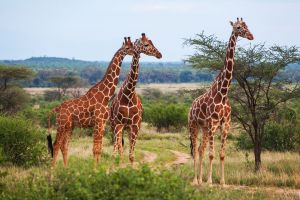
Giraffe
Videnskabeligt navn: Giraffe camelopardalis Underarter: Girafferne deles normalt op i to grupper: de nordlige og de sydlige. De Nordlige: Nubian Giraffe (G.c.camelopardalis) Reticulated Giraffe (G.c.reticulata) Baringo Giraffe (G.c.rothschildi) De Sydlige: Kenya Giraffe (G.c.tippelskirchi) Southern Giraffe (G.c. Giraffa) Udbredelse: De forskellige girafarter har et fælles...
Read more
Grey Rhebok/Vaal Rhebuck
Scientific Name: Pelea capreolus Subspecies: None Distribution: South Africa Habitat: Grassy hills and mountains, up on the flat tops. Description: Small antelope with a shoulderheight of 70 cm and a weight of 25 - 30 kg. General colour brownish grey, tinged with fulvous on head and limbs. The fur is very soft. The horns are black and very slender, nearly straight and vertical,parallel to...
Read more
Greywing francolin
Scientific name: Scleroptila afra Distribution: It is common in southern Africa. Habitat: The grey-winged francolin daily occurs in mountainous regions. In someplace the hunting districts where they live can only be reached on horseback. It is found in flocks of up to 25 birds in the mountains of Eastern Cape and Natal. Description: It is one of the most challenging birds to shoot in South...
Read more
Hartebeest, Red
Scientific Name: Alcelaphus b caama Subspecies: Is itself a subspecies of Alcelaphus buselaphus. Distribution: South Africa, Namibia, Botswana and Angola Habitat: Open grassland and savanna. Description: Middlesized antelope, that weighs around 170 kg and measures 120 - 140 cm over the shoulder. General colour light reddish brown. The horns are black and heavy, curved at first slightly...
Read more
Helmeted Guineafowl
Scientific name: Numida meleagris Distribution: It is originally from sub-saharan Africa but was later introduced to the West Indies, Brazil, Australia and Europe Habitat: Helmeted Guineafowl lives in open, dry grasslands and savannah with sparse growth of trees and bushes. It is often also found on farmland. Description: It is the most famous and widespread wild bird in South Africa. It is...
Read more
Hippopotamus
Videnskabeligt navn: Hippopotamus amphibius Underarter: Ingen. Udbredelse: I stort set samtlige lande syd for Sahara. Levested: Langs floder og i søer. Beskrivelse: Flodhesten er næst efter elefanten det største landlevende pattedyr. Flodhesten har en kompakt krop og korte kraftige ben. Den opnår en vægt på op til 3,5 tons og en højde på 1,5...
Read more
Hottentot teal*
Scientific name: Spatula hottentota Distribution: It is common in southern and east Africa, typically south of 10 ° S. Habitat: The Hottentot teal mainly lives in large open areas of freshwater and wet grasslands with emergent vegetation. It largely lives off aquatic plants, and is normally found in water that is less than 1.5m in depth. Description: The size of an Hottentot teal, with...
Read more
Hyrax
Scientific Name: Procavia capensis Subspecies: N/A Distribution: Across sub-Saharan Africa, except in the Congo basin and Madagascar. Also occurs in the southern Algeria, Libya, Egypt and the middle east. Habitat: They build their dwellings in any type of rock offering suitable cavaties and soils. Description: A small, squat heavily built mammal around 50cm in length. It has thick fur from...
Read more
Impala
Scientific Name: Aepyceros melampus Subspecies: East African Impala (Aepyceros m. rendillis) Angola Impala (Aepyceros m. petersi) Distribution: South Africa, Mozambique, Zimbabwe, Botswana, Namibia, Angola, Zambia, Tanzania, Kenya, Uganda and Congo (Zaire) Habitat: Open bush and Acacia savanna Description: The three species are here descriped as on as the difference in appearance is negligent...
Read more
Klipspringer
Videnskabeligt navn: Oreotragus oreotragus Underarter: Ingen. Udbredelse: Sydafrika, Namibia, Botswana, Zimbabwe, Mozambique, Angola, Zambia, Tanzania, Kenya, Congo, Etiopien Sudan. Levested: Små isolerede klippeformationer samt bjerge. Beskrivelse: Lille antilope med en vægt på 10 - 15 kg og en skulderhøjde, der normalt ikke overstiger 60 cm. Klipspringeren er...
Read more
Knob-billed duck*
Scientific name: Sarkidiornis melanotos Distribution: The knob-billed duck is widespread in the tropical wetlands of South Africa, Madagascar, south Asia and the very south of China. Habitat: It mainly lives in tropical marshes, rivers and large areas of open grassland. It primarily lives off aquatic plants and will usually be found close to water. Description: It is the size of an Egyptian...
Read more
Kudu, East Cape
Scientific Name: Tregelaphus strepsiceros strepsiceros Subspecies: The East Cape Kudu is a subspecies of the Greater Kudu,. Distribution: Only occurs in the East Cape region of South Africa. Habitat: Its preferred habitat is woodland (especially thornveld) close to water, but can occur in semi desert and thick valley bushveld with sufficient food and cover. Description: Large, elegant...
Read more
Kudu, Greater
Scientific Name: Tragelaphus strepsiceros Subspecies: Southern Greater Kudu (Tragelaphus strepsiceros strepsiceros) East African Greater Kudu (Tragelaphus str. bea). Western Greater Kudu (Tragelaphus str. cottoni) Distribution: From Chad, Sudan and Ethiopia in the North through all countries along the East coast as well as Zimbabwe, Zambia, Namibia, Botswana, Angola and South Africa. Habitat:...
Read more
Kudu, Lesser
Scientific Name: Tragelaphus imberbis Subspecies: Tragelaphus i. australis Distribution: Ethiopia, Somalia, Uganda, Tanzania and Kenya. Habitat: Dense Bush Description: Looks much like the Greater Kudu, but has got a shoulderheight of 100 cm and an average weight of 90 - 100 kg. However, Lesser Kudu has more white side stripes than its larger cousin (Greater Kudu ca. 7, Lesser ca. 9) Hunting...
Read more
Laughing dove
Scientific name: Spilopelia senegalensis Distribution: It is common in sub-saharan Africa, Saudi Arabia, Iran, Pakistan and India. Habitat: It is very common in most urban areas, where it favours both large and small trees in parks and gardens. In sunflower and corn fields close to towns it offers excellent sport for wing shooters as it is very fast flying. Description: It is a small...
Read more
Namaqua sandgrouse*
Scientific name: Pterocles namaqua Distribution: It is widespread in South Africa and a number of other African countries. Habitat: The Namaqua sandgrouse lives in the drier parts of South Africa. It is common in the Kalahari desert, Namo Karoo and in parts of the Western Cape. This species only needs seeds, some gravel and easy access to some form of freshwater to surviveTheir habitat usually...
Read more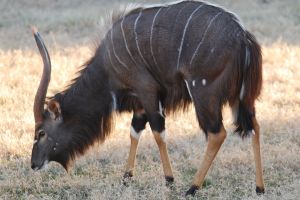
Nyala
Videnskabeligt navn: Tragelaphus angasi Underarter: Ingen. Udbredelse: Sydafrika, Mozambique, Zimbabwe, Zambia og Malawi. Levested: Tæt bush og i krat langs floder og vandløb. Beskrivelse: Middelstor antilope på 110 - 130 kg og en højde på 110 - 120 cm. Pelsfarven er gråbrun med hvide og lysebrune aftegninger. Nyalaen har ca. 11 hvide tværstriber....
Read more
Orange River francolin
Scientific name: Scleroptila gutturalis Distribution: It is common in South Africa but also occurs in a number of other African countries Habitat: The Orange River francolin lives in large grasslands, cornfields and woods. It can be found throughout the Free State province and in parts of Mpumalanga nas Northern Cape Description: It is similar to the redwing francolin in appearance but...
Read more
Oribi
Videnskabeligt navn: Ourebia ourebi Underarter: Der anerkendes op til 13 underarter. Den eneste underart, der adskiller sig tydeligt fra de andre er Haggard Oribien Udbredelse: Sydafrika, Mozambique, Zimbabwe, Botswana, Namibia (Caprivi), Angola, Zambia, Tanzania, Kenya, Somalia, Sudan, Chad, C.A.R, Cameroun, samtlige vestafrikanske stater til Senegal. Levested: Åben bush og...
Read more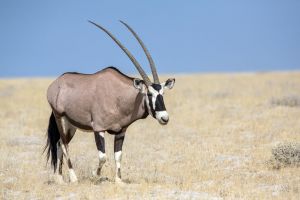
Oryx, Gemsbok
Scientific Name: Oryx gazella gazella Subspecies: Beisa Oryx (Oryx g. beisa) Fringe-eared Oryx (Oryx g. callotis) Distribution: South Africa, Botswana, Namibia and Angola. Habitat: Dry plains and sub-desert. Description: Large antelope with a very compact body. The Gemsbok reaches a weight of 220 kg and a height of around 120 cm. General colour pale fawn grey, with striking patternon head and...
Read more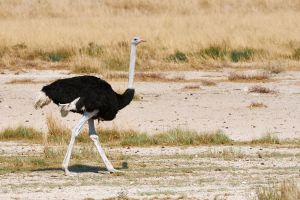
Ostrich
Scientific Name: Struthio camelus Subspecies: There are three living and one extinct subspecies of common ostrich: North African Ostrich(S. c. camelus), South African Ostrich (S. c. australis), Masai Ostrich (S. c. massaicus) and the extinct Arabian Ostrich( S. c. camelus). Distribution: The Sahel, parts of East Africa and Southern Africa Habitat: Plains, open thorn bush country and...
Read more
Porcupine, Cape
Scientific Name: Hystrix africae-australis Sub - species: None Distribution: Sub-saharan Africa, excluding the Namib desert. North to southern Kenya and Gabon. Habitat: Found in most areas with vegetation, up to 200m above sea level. Prefers rocky hills and outcrops, as it can find shelter in caves and hollows during the day. Description: The largest rodent in the region, with very...
Read more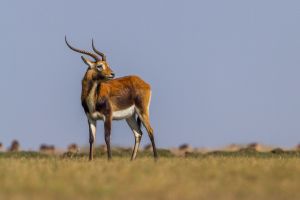
Red Lechwe/Black Lechwe/Kafue Lechwe/Moor Antilope
Scientific Name: Kobus leche Subspecies: Kafue Lechwe (Kobus l. kafuensis) Black Leckwe (Kobus l. Smithemani) Distribution: Lechwe: Botswana, Namibia, Zambia and Angola Kafue Leckwe: Zambia and Congo (Zaire) Black Lechwe: Zambia (Bangweolo swamps) Habitat: Swamps and wetlands (see Sitatunga) Description: The tree species will be described as one as the difference between them is negligent:...
Read more
Redbilled teal
Redbilled teal - Denne and har en mørkerød regning og findes i flokke på op til 25 fugle. Det er en meget hurtig, undvigende og kronglet fugl under flugt. Fundet i ferskvand ikke dybere end 1,5 meter og mindre. Skuddene foregår hovedsageligt fra huder, der er strategisk placeret omkring eller i nærheden af vand under flyveveje. Hvor det er relevant, hvor man vader sig i vandet mellem...
Read more
Redeye pigeon
Scientific name: Streptopelia semitorquata Distribution: It is widespread over much of sub-saharan Africa Habitat: It has become adapted to urban areas where it lives in park and garden trees. Hunting takes place on large fields within a radius of 3 -8 km fro large towns. Description: It has a grey/pink body with orange/red eyes and has a ring of bare skin around the eye. The back, wings and...
Read more
Reedbuck (Common)
Scientific Name: Redunca arundinum Subspecies: None Distribution: Angola, Southern part of Congo, Southern Tanzania, Zambia, Mozambique, Zimbabwe, Botswana, Namibia (Caprivi) and South Africa. Habitat: Open bush and savanna Description: Middlesized antelope with a shoulderheight of up to 100 cm and a weight of 70 - 80 kg. General colour uniform greyish fawn, tinged with brown, with a white...
Read more
Reedbuck, Mountain
Scientific Name: Redunca fulvorufula Subspecies: We use Asell's classifying which recognizes 3 subspecies: Chanler's Mountain Reedbuck (Redunca f. chanleri) Redunca f. adamauae (this species has not a common name, and very little is known about it.). Distribution: Mountain Reedbuck: South Africa Chanler's Mountain Reedbuck: Tanzania, Kenya and Ethiopia. Redunca f. adamauae: Cameroun and...
Read more
Roan
Videnskabeligt navn: Hippotragus equinus Underarter: Der anerkendes 6 underarter men vi har valgt kun at medtage de arter der er tilgænglige for trofæjægere idag. East African Roan (Hippotragus e. langheldi) Western Roan (Hippotragus e. koba) Udbredelse: Southern Roan: Sydafrika, Mozambique, Zimbabwe, Zambia og Botswana. East African Roan: Tanzania, Kenya. Western Roan: Fra de...
Read more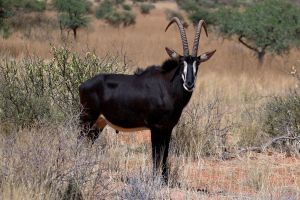
Sable Antelope (Africa)
Videnskabeligt navn: Hippotragus niger Underarter: Hippotragus n. kirkii, Hippotragus n. roosevelti. Giant Sable (Hippotragus n. Variani) beskrives ikke da den på nuværende tidspunkt er truet af udryddelse. Udbredelse: Sydafrika, Mozambique, Zimbabwe, Zambia Botswana, Namibia, Tanzania og Kenya. Levested: Åben bush og græssletter men findes også ofte i miombo- og...
Read more
Sassabe
Videnskabeligt navn: Damaliskus lunatus Underarter: Topi (Damaliscus l. jimela) Western Topi, Korrigum (Damaliscus l. purpurescens) Tiang (Damaliscus l. tiang) Udbredelse: Tsesseby: Sydafrika, Mozambique, Zimbabwe, Zambia, Botswana, Namibia, Angola. Topi: Kenya, Tanzania og Uganda. Western Topi: Senegal, Gambia, Burkina Faso, Nigeria, Cameroun, C.A.R, Chad, Sudan. Tiang: Sudan, Ethiopien,...
Read more
Scimitar Oryx/Scimitar-Horned Oryx
Scientific Name: Oryx dammah Subspecies: None Distribution: Chad, Niger, Mali and Sudan. Habitat: Sahel and semi-desert, even desert in Northern Africa. Description: Large antelope (150-200 kg) with a compact body, very pale coloured with no striking pattern on the body. Neck and chest ruddy brown, body white, washed with russet. Its ears bears a tuft of long black hair. Hunting method:...
Read more
South African Shelduck*
Scientific name: Tadorna cana Distribution: It is native to southern Africa and is today common in Namibia and South Africa. Habitat: It can be found on large open areas of freshwater and on grassland. It lives mainly off aquatic plant so it is rarely seen far from large bodies of freshwater Description: It has a reddish body and wings with that are vividly marked with black, white and green....
Read more
South African springhare
Scientific Name: Pedetes capensis Subspecies: None recognised Distribution: Southern Africa Habitat: Open dry country, mostly on sandy soils. Description: A large rodent, almost kangaroo-like in appearance. Colour can vary from reddish-brown to pale grey, tail has a black tip . Body length 36 -45cm plus a long tail of 36 - 47 cm in length. Hunting method: Hunting at night, or if the chance...
Read more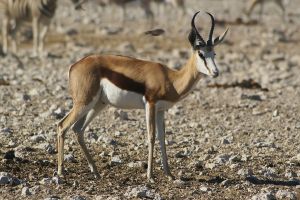
Springbuck/Springbok
Scientific Name: Antidorcas marsupialis Subspecies: Antidorcas m. hohmeyeri, a. m. angolensis. Distribution: From Angola in the North till the northern parts of South Africa with main distribution in Namibia and Botswana. Habitat: Open dry plains and semi-desert. Small gazelle with relatively long legs. The Springbok reaches ca. 95 in height and has an average weight of 25 - 45 kg. General...
Read more
Springbuck/Springbok, Black
Scientific Name: Antidorcas marsupialis Subspecies: The black springbok is one of the colour phases of springbok, that have been bred on some South African game farms from naturally occurring animals. Distribution: South Africa Habitat: Dry grasslands, bushlands and scrublands of southern Africa. Description: A slender antelope species, up to 84cm high at the shoulder and weighing ...
Read moreSpringbuck/Springbok, Copper
Scientific Name: Antidorcas marsupialis Subspecies: The copper springbok is one of the colour phases of springbok, that have been bred on some South African game farms from naturally occurring animals. The first copper springboks was found in Orange Free State. Distribution: South Africa Habitat: Dry grasslands, bushlands and scrublands of southern Africa. Description: A slender antelope...
Read moreSpringbuck/Springbok, White
Scientific Name: Antidorcas marsupialis Subspecies: The white springbok is one of the colour phases of springbok, that have been bred on some South African game farms from naturally occurring animals. It originally arose in Eastern Cape Province. Distribution: South Africa Habitat: Dry grasslands, bushlands and scrublands of southern Africa. Description: A slender antelope species, up to 84cm...
Read more
Spur-winged goose
Spurwing - En stor sort gås med hvide pletter, der kan lide pander og søer tæt på græsarealer og landbrugsarealer, som den kan lide at komme i land at fodre på. Disse fugle har store skarpe sporer på vingerne. Spurwing gåsen er den største vandfugl gamebird i Sydafrika, der vejer op til 10 kilo og med et vingespænde på op til 1,8 meter og er fortsat det ultimative trofæ. Flokke på op...
Read more
Steenbuck/Steenbok
Scientific Name: Raphicerus campestris Subspecies: Authors dissagree on the number of subspecies, and 1 to 8 subspecies are more or less recognized. Distribution: South Africa, Namibia, Angola, Botswana, Zimbabwe, Zambia, Mozambique, Kenya and Tanzania. Habitat: Open plains with bush and very little woodland. Description: Small antelope weighing 10 - 15 kg with a shoulder height normally not...
Read more
Swainson francolin
Scientific name: Pternistis swainsonii Distribution: It is widespread in South Africa and can be found in a number of other African countries Habitat: The Swainson francolin is mainly found in areas with torntrees, grassland and farmland. Description: It is brown with a characteristic red head and it is very popular with hunters as it is a strong, fast flier. It is similar in...
Read more
Vervet Monkey
Scientific Name: Chlorocebus pygerythrus Species: There are five recognised subspecies of vervet monkey:Chlorocebus pygerythrus excubitorC. p. hilgerti - found in southern KenyaC. p. nesiotesC. p. pygerythrus found in South Africa, Botswana, Lesotho and SwazilandC. p. rufoviridis found in Uganda and Mozambique Distribution: East Africa for Ethiopia south to South Africa Habitat:...
Read more
Warthog
Videnskabeligt navn: Phacochoerus aethiopicus Underarter: Der anerkendes op til 7 underarter, der her beskrives under et. Udbredelse: Hele Afrika syd for Sahara med undtagelse af den vestafrikanske regnskov samt ørken områder i Namibia. Levested: Åben bush og græssletter. Beskrivelse: Mindre griselignende dyr der opnår en vægt på 100 kg og en...
Read more
Waterbuck
Videnskabeligt navn: Kobus Defassa Underarter: Common Waterbuck (Kobus d. ellipsiprymnus), Defassa Waterbuck (Kobus d. defassa) Crawshay's Waterbuck (Kobus d. crawshayi). Sing Sing Waterbuck (Kobus d. unctuosus) Udbredelse: Defassa Waterbuck: Kenya, Tanzania, Ethiopien Sudan. Common Waterbuck: Sydafrika, Mozambique, Zimbabwe, Botswana, Zambia, Tanzania, Kenya, Sudan. Crawshay's Waterbuck:...
Read more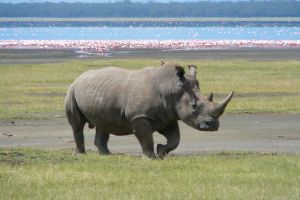
White Rhinoceros
Scientific Name: Ceratotherium Simum Subspecies: Ceratotherium s. cottoni. Distribution: South Africa, Sudan and Zimbabwe (------). Due to civilwar in southern Sudan it is difficult to judge how many White Rhinos are actually left in the area. The most negative report say that it is now totally extinct in Sudan. Others are of the opinion that some individuals may have escaped into Uganda. In...
Read more
Whitefaced duck*
Scientific name: Dendrocygna viduata Distribution: It is common in southern and east Africa and over most of South America. Habitat: It is mainly found on large, open areas of freshwater and nearby grasslands. It feeds on aquatic plants and is most commonly found on water less than 1.5m deep. Description: The white-faced duck has a red brown body with greyish wings. It has a black neck and...
Read more
Yellowbilled duck
Scientific name: Anas undulata Distribution: Yellow-billed duck are widespread over much of sub-saharan Africa. Habitat: It lives on large wetlands, rivers and lakes. Description: The yellow-billed duck is the size of a mallard. The plumage is largely grey, with a darker head and a yellow bill. It is very fast flying which makes it a challenging bird to shoot. Hunting Method:...
Read more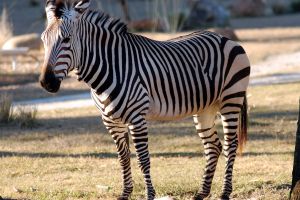
Zebra, Mountain
Videnskabeligt navn: Equus zebra Underarter: Hartmann's Mountain Zebra (E.z.hartmannae) Udbredelse: Mountain Zebra: Sydafrika. Hartmann's Mountain Zebra: Namibia. Levested: Åben bush og græssletter. Beskrivelse: Hestelignende dyr der opnår en vægt på 250 kg og en højde målt over s skuldrene på ca. 130 cm. Skindet er stribet i hvid og brunsorte...
Read moreHunting Area

Bush Camp / Coastal Camp / Mountain Camp
E-Zulu Safaris in Eastern Cape offer really exclusive hunting arrangements for the more discerning hunter and his companions. The hunting areas are exceptional good with varied nature and big populations of game. The hunting areas are - like the rest of Eastern Cape - malaria free. The facilities for non-hunting guests are among the best in Africa and here we name some of them: Game drives,...
Read more
Eastern Cape Coastal
Jagtområdet ligger mellem Kenton-on-Sea, Port Alfred og Grahamstown – langs en af de mest uberørte strande i landet. Der fokuseres på jagt på Blue Duiker, Caracal, Cape Bushbuck, Oribi, Cape Grysbok og Common Duiker. Her kan desuden ses en række af pattedyr og fugle såsom Footed Gerbil, Large-spotted Genet, Tree Dassie, Black-backed Jackal, Cape...
Read more
Eastern Cape Midlands
Der jages Kudu, Waterbuck, Nyala, Oryx, Blue Wildebeest, Black Wildebeest, Impala, Mountain Reedbuck, Common Reedbuck, Black og white springbuck, Bontebok, Cape Eland, Burchell’s Zebra, Red Hartebeest, Red Lechwe, Fallow Deer, Steinbuck, Common Duiker, vortesvin, Bushpig og mange flere. Jagten foregår til fods i kuperet terræn og det er en forudsætning, at jægeren er...
Read more
Free State province
RH Safaris offer hunting on more than 100,000 hectares of land in different parts of South Africa. The land is privately owned, and will not be shared with other groups while you are hunting. This wingshooting districts are managed sustainably, and some districts are only used every 4th week. More than 90% of our wingshoots takes place in Free State Province, in the regions of Vaaldam, Vaal,...
Read more
Frontier Safaris
Frontier Safaris´ hunting area is one big area of 27.000 hectares - with open plains, mountains and thick bush. In the hunting area you can hunt a lot of different species, however none of the Big Five, but there is a very big variety of antelopes from the small Blue Duiker to the big Cape Eland. Although it is sold at discount prices, there is nothing lacking with the hunting,...
Read more
Gers Safaris
Gers Safaris offers some of the best hunting opportunies on the continent. This is not canned hunting, but rather the thrilling, pulse racing, adrenaline thumping real deal. Vegetation is thick bush with clearings (pans) ideal for stalking. Your skills as a hunter will be challenged in many ways that you have never experienced before. Both bow and rifle hunting are accommodated at Gers...
Read more
Loock Safaris
As this hunting district lies at 1,000m above sea level, the climate can vary markedly from summer to winter. The terrain which varies from mountainous to huge open plains with sparse vegetation covers some 15,000 ha.. look Safari’s also have access to a number of neighbouring districts. The hunt takes place in an area in Eastern Cape Province, some 3 hours drive north of Port Elizabeth...
Read more
The Hunting District in Limpopo Province
The hunting district in Limpopo Province covers a total of 20,000 hectares and after many years of selective, ethical and fair-chase hunting, they can now offer a wide range of top class trophies. The quality and diversity found in the hunting district provides perfect conditions for the animals, and helps give you the hunting adventure of a lifetime. Gaspare Spanio Safaris offer excellent...
Read morePartner

African Echo Safaris
The owner of African Echo Safaris is Glaeser Conradie. Glaeser is South African and for many years has enjoyed a successful career as an outfitter and PH (Professionel Hunter) in Mozambique, South Africa, West and Northern Africa. He is a skilful, likeable and very committed PH with a wealth of hunting experience from a wide range of African countries. He really loves to work hard to achieve our...
Read more
E-Zulu
We have now been working with E-Zulu Safaris for three seasons, and without boasting we dare to say that this is the best of the best, when you talk about hunting trips to South Africa. Do you want to be spoiled, or do you want to spoil your closest ones, then book a trip to E-Zulu Safaris in Eastern Cape. Everything that has to do with E-Zulu, is top class. They know that they have a unique...
Read more
Frontier Safaris
Frontier Safaris arrange hunting in their own area Burchell Game Reserve in the Eastern Cape Province in South Africa. This area is situated about 110 km from the airport in Port Elizabeth (you fly domestic from Johannesburg to Port Elizabeth). Frontier Safaris naturally pick-up and take back their guests from/to Port Elizabeth. Burchell Game Reserve is incredible 27.000 hectares. A really...
Read more
Gaspare og Eleen
The Lodge is owned by Gaspare and his wife Ellen. They have been welcoming guests to their lodge in South Africa for many years now, and their priority has always been to ensure guests have an enjoyable stay that they will remember for years to come. While you enjoy the luxury of the lodge you will simultaneously experience the beautiful African bush and all its wildlife. At GS Safaris you can...
Read more
Gers Safaris
Our only partner in the Northern Cape. Gers Safaris is managed by the husband and wife team of Madelene and Julius Gers, Professional Hunter Ronald Stock and Lodge Manager Lee Stock, who take pride in giving their guests not only unforgettable hunting, but also high class culinary experiences. Gers Safaris makes your safari dream a reality. Here you will quickly feel at home,...
Read more
Loock Safaris
Over the last few years we have had many groups enjoying some fantastic driven hunting with Loock Safaris. The farm is owned by Flippie Loock, who has a great reputation - not just in South Africa, but all the way up to here in Scandinavia. You will need to look far and wide for a more genuine person than him, and we are really glad to be able to work in partnership with this great character.
Read more
RH Safaris
Our outfitter, the owner of the company RH Safaris, has more than 20 years of hunting experience in South Africa, an interest that started at a very young age. His great passions are wingshooting and hunting plains game and over the last 15 years he has started bow hunting. The districts that RH Safaris can offer are some of the best hunting districts for wild birds in the whole world. A lot of...
Read more









